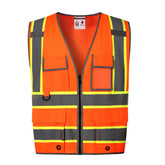What PPE Should Electricians Wear (OSHA-Compliant Guide)
Electricians face serious risks on the job—from electric shock to arc flash and burns. Understanding what personal protective equipment (PPE) is required and how it aligns with OSHA standards is essential to maintaining a safe and compliant workplace. At HiVisPro, we specialize in high-visibility safety apparel, but this guide provides a comprehensive overview of PPE for electricians working in the U.S.
Understanding the Hazards in Electrical Work
Electrical work exposes professionals to energized parts, conductors, and circuits. Common hazards include electric shock, arc flash, burns, and explosions. According to the Occupational Safety and Health Administration (OSHA), PPE serves as the last line of defense when engineering and administrative controls cannot fully eliminate these risks. (osha.gov)
OSHA Standards and Employer Responsibilities
OSHA regulation 29 CFR 1910.335 requires that employees exposed to potential electrical hazards must be provided with and must use protective equipment suitable for the task. In addition, 29 CFR 1910.137 sets standards for insulating gloves, sleeves, and blankets, including design, care, and testing requirements. Employers are responsible for hazard assessments, proper PPE selection, training, and maintenance to ensure compliance.
For the power generation, transmission, and distribution sectors, OSHA further specifies the use of safety glasses, hard hats, insulating gloves and sleeves, leather protectors, flame-resistant (FR) clothing, and safety footwear. (osha.gov)
Essential PPE for Electricians
Head, Eye, and Face Protection
Non-conductive hard hats protect against shock and impact. Safety glasses or goggles shield against debris, and face shields provide additional arc-flash protection. OSHA § 1910.335(a)(1)(iv) mandates the use of non-conductive head protection wherever there is a risk of electric shock or burns.
Hand and Arm Protection
Insulating rubber gloves and sleeves are critical when working on or near live circuits. They must be appropriately rated (Class 00–4) for voltage levels and inspected before each use. Employers must ensure periodic electrical testing per OSHA § 1910.137(c).
Body and Torso Protection
Arc-rated or flame-resistant (FR) clothing minimizes thermal injury during an arc-flash event. Garments should meet ASTM F1506 or equivalent standards. While hi-visibility clothing is not a substitute for arc-rated PPE, it can be layered over FR apparel if rated accordingly.
Footwear and Other Protection
Electricians should wear non-conductive, voltage-rated safety boots to prevent current flow through the body. Additional protection may include insulating mats, protective shields, and insulated tools, as required by OSHA § 1910.335(a)(2)(i).
The Role of High-Visibility Apparel
Although not directly rated for electrical hazards, hi-visibility apparel plays a supporting role for electricians who work in low-light or high-traffic environments—such as outdoor substations or road-adjacent job sites. Hi-vis gear helps prevent struck-by and caught-between incidents by improving worker visibility, especially when combined with reflective materials and compliant color standards (ANSI 107). HiVisPro’s hi-vis clothing complements arc-rated PPE by ensuring visibility without compromising safety.
Selection, Use, and Maintenance Tips
-
Assess hazards: Evaluate tasks, voltage exposure, and potential arc-flash energy.
-
Select appropriate ratings: Match PPE to hazard levels.
-
Inspect regularly: Check insulating gloves, sleeves, and FR garments before each use.
-
Train employees: Workers must know when and how to wear PPE, its limitations, and maintenance requirements.
-
Maintain and store properly: Keep PPE clean, dry, and free from damage or contamination.
-
Ensure proper fit: Ill-fitting PPE can reduce protection and increase risk.
Conclusion
For electricians, PPE is more than a compliance requirement—it’s a life-saving necessity. From insulating gloves to non-conductive helmets and flame-resistant clothing, every item has a purpose. By following OSHA standards and implementing a thorough hazard assessment program, electrical professionals can work safely and confidently. HiVisPro remains committed to supporting workplace safety through durable, high-visibility apparel that complements comprehensive PPE programs.





